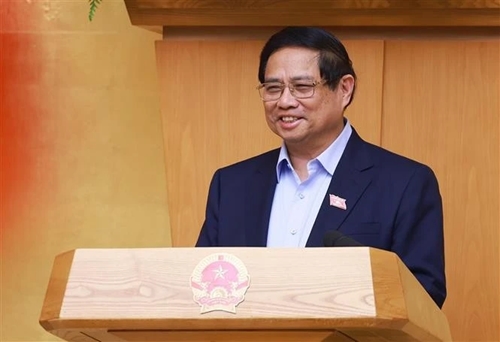At the meeting, which focused on expediting the reorganization of administrative units and the implementation of a two-level local government model, Prime Minister Pham Minh Chinh also called for clear guidance regarding the management of public assets and facilities throughout the restructuring process.
According to the Government’s steering committee for the reorganization, all localities have established dedicated steering bodies and issued detailed implementation plans. Public consultation on the restructuring proposals has achieved nearly 96% approval nationwide, with full support from People's Councils at all levels.
    |
 |
|
Prime Minister Pham Minh Chinh addresses the Government meeting on May 9. |
As of May 8, proposals and documentation for restructuring administrative units in all 63 provinces and cities—consolidated into 34 proposed provincial-level units—were completed and prepared for submission to the National Assembly and its Standing Committee. Under the new plan, Vietnam is expected to reduce the number of provincial-level administrative units from 63 to 34, and commune-level units from 10,035 to 3,321, down 29 and 6,714 respectively.
Post-reorganization, provincial-level civil servants are projected to number approximately 91,784, a reduction of 18,449, while commune-level civil servants will total over 199,000, down by roughly 110,000. Additionally, more than 120,000 non-permanent local officials will be released from service.
This streamlining is estimated to save the state budget around VND 190.5 trillion (approx. USD 7.33 billion) in salary and administrative costs between 2026 and 2030. Conversely, the restructuring process is expected to require approximately VND 22 trillion for provincial-level redundancy payments, VND 99 trillion at the commune level, and VND 6.6 trillion for early retirement-related social insurance contribution.
Participants at the meeting highlighted the complexity and urgency of the reorganization, which spans multiple sectors and demands coordinated efforts. They emphasized the need for transparency and fairness in personnel management, equitable distribution of benefits, and the uninterrupted provision of public services throughout the transition.
In his concluding remarks, Prime Minister Pham Minh Chinh endorsed the Government’s final proposals for submission to the National Assembly. These outline a reduction of provincial-level units from 63 to 34, and commune-level units from 10,035 to 3,321, a 66.91% decrease, and the elimination of district-level administrative units.
He underlined the high level of public consensus supporting the changes and stressed that citizens expect newly structured local governments to operate more efficiently and serve people and businesses more effectively.
In parallel with the restructuring, the Government and relevant ministries are urgently drafting accompanying legal documents. These will follow the principle of “one law amending many laws, one document amending many documents,” with immediate issues addressed promptly and others requiring further assessment handled with careful deliberation, avoiding both haste and excessive caution.
The PM reiterated the importance of robust support policies for affected personnel and affirmed that the new administrative structures must be implemented without disrupting public services.
He instructed that all required documentation be completed swiftly for submission to the National Assembly, with immediate implementation upon approval. Continuous monitoring is essential to promptly identify and address emerging challenges.
The Ministry of Finance was tasked with urgently disbursing funds to support those released from service, while localities were directed to review human resource planning to prevent service delivery gaps. Full adherence to decentralization policies was stressed, alongside the establishment of public service centers that operate independently of administrative boundaries.
Simultaneously, ministries and localities must continue fulfilling regular and urgent national tasks—most notably achieving a GDP growth target of at least 8% in 2025 and resolving over 2,200 stalled projects involving VND 6 quadrillion and more than 300,000 hectares of land.
Prime Minister Pham Minh Chinh also underscored the strategic importance of implementing key Politburo resolutions, including those on breakthroughs in science, technology, innovation, and digital transformation; international integration; legal reform; and strengthening the private sector’s role in economic development.
He concluded the meeting by calling for high determination, decisive action, and clearly defined responsibilities and deliverables to ensure Vietnam progresses firmly into a new era.
Source: VNA